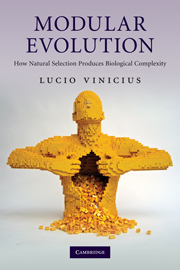Book contents
- Frontmatter
- Contents
- Preface
- 1 From natural selection to the history of nature
- 2 From the units of inheritance to the origin of species
- 3 Multicellularity and the developmental code
- 4 Life cycle evolution: life and death of the soma
- 5 Sex and its consequences: the transition that never happened
- 6 Animal societies: the case of incomplete evolutionary transitions
- 7 The new ‘Chain of Being’: hierarchical evolution and biological complexity
- References
- Index
3 - Multicellularity and the developmental code
Published online by Cambridge University Press: 05 June 2012
- Frontmatter
- Contents
- Preface
- 1 From natural selection to the history of nature
- 2 From the units of inheritance to the origin of species
- 3 Multicellularity and the developmental code
- 4 Life cycle evolution: life and death of the soma
- 5 Sex and its consequences: the transition that never happened
- 6 Animal societies: the case of incomplete evolutionary transitions
- 7 The new ‘Chain of Being’: hierarchical evolution and biological complexity
- References
- Index
Summary
Despite the drawbacks of Fisher's argument, evolutionary gradualism remains the most accepted explanation for organic diversity. Even Orr (2001: 121), who revealed the flaw in the micromutational approach, agrees that ‘alleles of large phenotypic effect (major genes) sometimes play a role in phenotypic evolution … but alleles of small effect are still more common than those of large effect’. Wright's ideas were also a direct blow against saltationist views. Under his shifting balance mechanism, the discontinuity of species results not from the discontinuity of variation (although macromutations can be accommodated within the model; see Wright, 1977), but from the geographic discontinuity of real populations and environments.
With genetics being absorbed into mainstream gradualism, saltationism had to seek refuge in what historically has been the most prolific source of anti-Darwinian ideas: developmental biology (Goldschmidt, 1940; Gould, 1977; Goodwin, 1994; Gilbert et al., 1996). Goldschmidt argued that the micromutations and allele polymorphisms studied by geneticists could only cause a limited degree of variation on a given species theme. But the origin of new species and body plans would require more radical phenotypic changes, triggered by factors exploring what he called the hidden ‘potentialities of development’. For Goldschmidt, mutations were relevant only as a source of systemic changes in development; however, those were not the more trivial micromutations studied by population geneticists but highly disruptive macromutations such as those known to cause the phenomenon of ‘homeosis’ (Bateson, 1894).
- Type
- Chapter
- Information
- Modular EvolutionHow Natural Selection Produces Biological Complexity, pp. 72 - 101Publisher: Cambridge University PressPrint publication year: 2010



